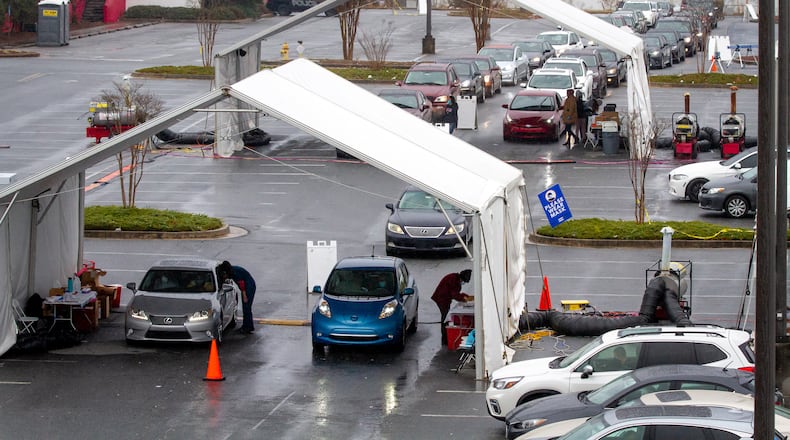The statistic is troubling.
Georgia is vaccinating people at a slower pace than any U.S. state, according to U.S. Centers for Disease Control and Prevention data.
Slightly less than 30,000 doses per every 100,000 Georgia adults have been administered as of Thursday, the data show. Alaska, which is first among states, has nearly twice that vaccination rate. New Mexico is not far behind.
And Georgia has consistently been near the bottom since federal officials began posting vaccination data.
In response, Gov. Brian Kemp has repeatedly criticized news coverage of the vaccination rate, citing other figures he says are more important, such as 66% of Georgians over the age of 65 have received at least one vaccine shot, above the national average of 60%.
He also has blamed supply shortages. Yet Georgia has been shipped hundreds of thousands more doses than it has administered.
Georgia’s problems
From the start of the vaccination rollout, Georgia has lagged in getting shots in arms because of technical challenges, distribution issues and communication gaps, according to a study released this week by Georgia State University researchers.
For example, some health centers had delays in receiving the PINs they needed to order doses, resulting in their waiting for their first shipment, the Georgia State team found.
The state’s vaccination rate at times also looked worse than it may have been because some facilities were slow in reporting vaccinations, the GSU researchers found.
“Confusion arose regarding how soon they needed to report administering a COVID-19 vaccine because the reporting window is different than the one for non COVID-19 vaccines,” they wrote. “All of these issues have compounded to set Georgia behind other states.”
Another issue: a mismatch in supply and demand. Kemp told reporters Wednesday that while some rural communities have been saturated with doses, meeting demand in metro Atlanta has been a challenge. State data shows about 33% of vaccinations have been administered in metro Atlanta’s five highest populated counties (Clayton, Cobb, DeKalb, Fulton and Gwinnett), although 36.5% of all Georgians live in those counties.
Amber Schmidtke, a public health researcher and former Mercer University professor who tracks Georgia’s epidemic on her widely read blog, said vaccine appointment websites which show relatively few available slots in the Atlanta area and many available in rural areas indicate an imbalance of demand.
“This might still be an issue where demand is really high in certain areas and less so in others,” she said. “Is it a factor of hesitancy or eligibility?”
If it is vaccine hesitancy, one missing component to Georgia’s vaccination effort has been a broad media campaign, experts said, featuring civic leaders and well-known Georgians of all demographic and political stripes.
Credit: Alyssa Pointer / Alyssa.Pointer@ajc.com
Credit: Alyssa Pointer / Alyssa.Pointer@ajc.com
Kemp, Public Health Commissioner Dr. Kathleen Toomey and other officials hold roundtables with community groups and promote the vaccines at news conferences and other appearances. On Wednesday, Insurance Commissioner John King, speaking in Spanish, addressed the state’s outreach efforts to encourage Latinos to get the vaccine.
Those efforts are important, but a mass media campaign would help reinforce those messages and reach more Georgians, Schmidtke said.
“There needs to be a large public awareness campaign on the safety of the shots, the effectiveness of the shots and how they will get us back to normal,” she said.
Doses shipped, not administered
The CDC data shows only six states have a larger gap between the number of vaccines delivered and and the number administered, raising concerns among experts that doses aren’t being used by some facilities.
Georgia has administered about 74% of the more than 3.3 million doses shipped, according to state data. Most states have rates greater than 80%, according to an AJC analysis of CDC data. Three states — New Mexico, North Dakota and Wisconsin — had vaccine administration rates greater than 90%.
Georgia has had 3,870 doses that weren’t used because they appeared contaminated, were damaged, not needed after being prepared or they leaked from the syringe, according to state Department of Public Health data that The Atlanta Journal-Constitution received Monday through an open records request.
But that accounts for only a tiny fraction of the gap.
Credit: Alyssa Pointer / Alyssa.Pointer@ajc.com
Credit: Alyssa Pointer / Alyssa.Pointer@ajc.com
In Georgia, the gap between vaccines shipped and administered is more than 850,000 doses, according to the DPH website Thursday. The CDC, which reports a higher delivery figure, put the gap Thursday morning at more than 1.3 million doses.
“When you are talking about 1 million doses on hand, that’s 20 days of supply on hand. That’s absurd,” Schmidtke said.
Each state gets a weekly shipment of vaccine based on the percentage of its adult population. The number of doses delivered to a state is the actual number of doses it ordered from the full amount of allocated doses available, a U.S. Health and Human Services department spokesman told The Atlanta Journal-Constitution.
Kemp has said the gap is skewed because some doses en route to Georgia are added to the shipped vaccine totals. He also said some hospitals have been holding back supplies for second doses of the Pfizer-BioNTech and Moderna vaccines.
Kemp’s case
The governor notes vaccinations are increasing in Georgia. More than 1 million inoculations have been done over the past 30 days.
Kemp’s team also notes Georgia ranks 12th nationally in the total number of doses administered, well ahead of border states such as Alabama, South Carolina and Tennessee.
Georgia, though, has the nation’s eighth-highest population, so it has received more doses than those states. Tennessee has the 15th largest population; South Carolina, the 23rd, and Alabama, the 24th.
The governor also said several times that the focus of his team has been on vaccinating older Georgians since they’ve died at higher rates. The first wave of eligible residents included those living in long-term care facilities, and on Jan. 11 Kemp expanded eligibility to all residents 65 and older.
“In this category, Georgia is well ahead of the national average, vaccinating nearly 1 million seniors, or 66% of the senior population. This is compared to the national average which hovers around 60% and is much lower in some other states,” Kemp spokeswoman Mallory Blount said via email.
Next week, the list of those eligible will expand to include all those 55 and older as well as adults with high-risk conditions. That addition means that the inoculation pool will cover categories that account for 92% of Georgia’s more than 15,000 confirmed coronavirus deaths, Kemp said Wednesday.
Still, some of those eligible have struggled to get appointments, prompting fed-up Georgians to flock to neighboring states to get shots when they were stymied here. Some other states also expanded their eligibility pools earlier.
For example, by mid-February, at least 28 states, the District of Columbia, and Puerto Rico made some or all teachers eligible to receive the vaccine, according to a tally by education news site, Education Week. Teachers began receiving shots in Georgia March 8.
What’s next
State officials believe vaccinations will rapidly increase as they receive more doses. The ongoing challenge will be to have the logistics, vaccination sites, appointment systems and personnel to get shots in arms.
State officials plan to soon double vaccinations at the Delta Flight Museum to address the demand issue in metro Atlanta.
The state opened four mass vaccination sites last month, operated by the Georgia Emergency Management and Homeland Security Agency (GEMA), and five more will open next week.
Federal officials plan to send about 42,000 doses a week to Mercedes-Benz Stadium in downtown Atlanta in an effort to increase vaccinations in underserved communities. The federal government will primarily staff the mass vaccination site. Federal and state officials are working out details on how people can sign up for shots.
The site is expected to be up and running in about another week, according to the announcement.
Kemp said Wednesday he hopes to expand vaccine eligibility to all adults by early April.
Credit: Ben Gray
Credit: Ben Gray
Keep Reading
The Latest
Featured



